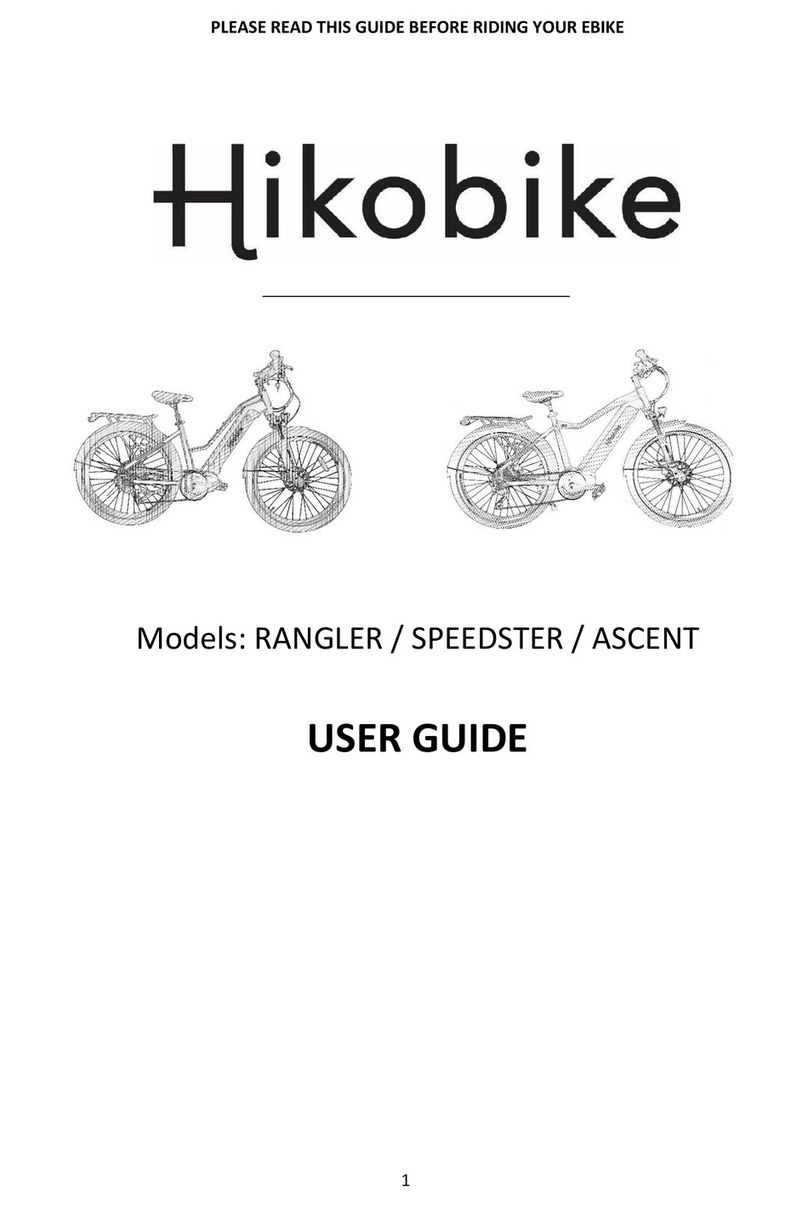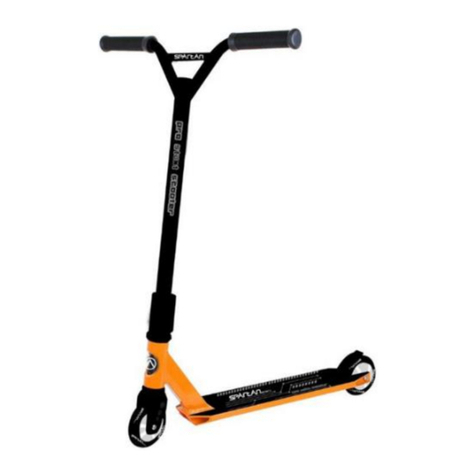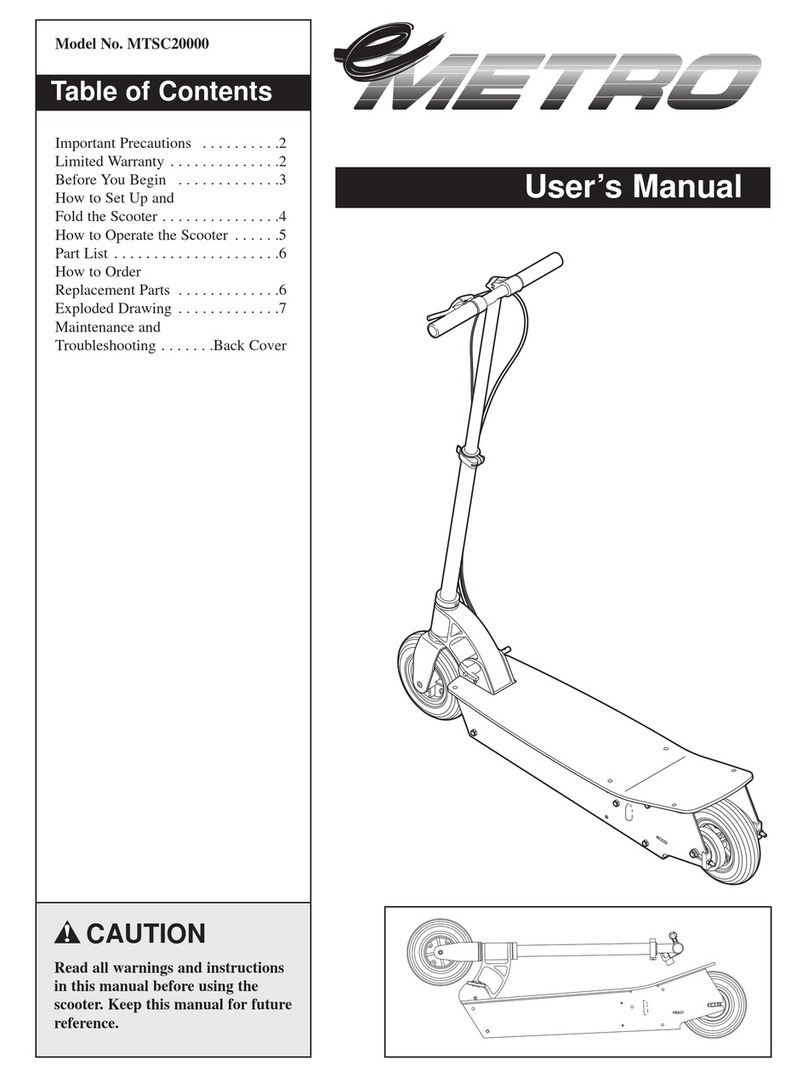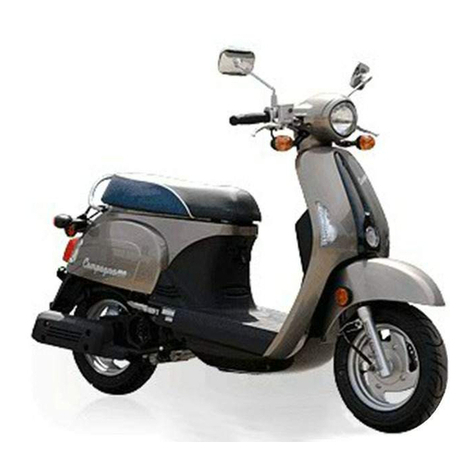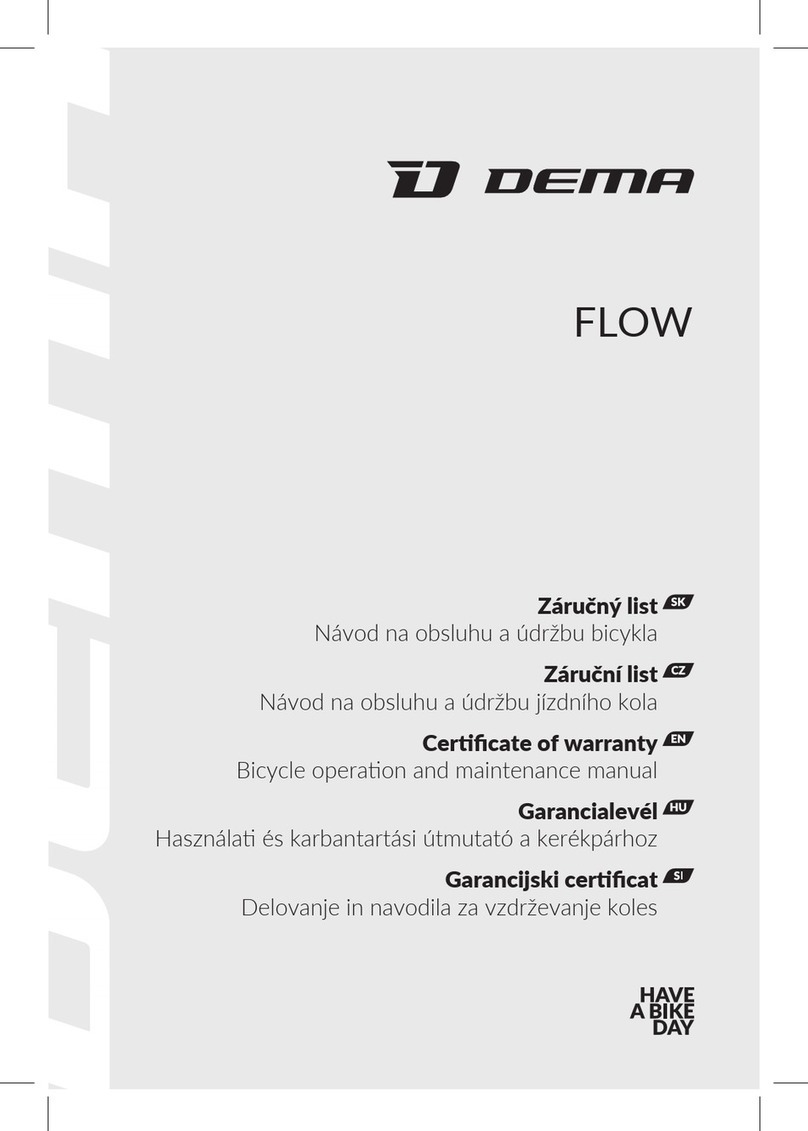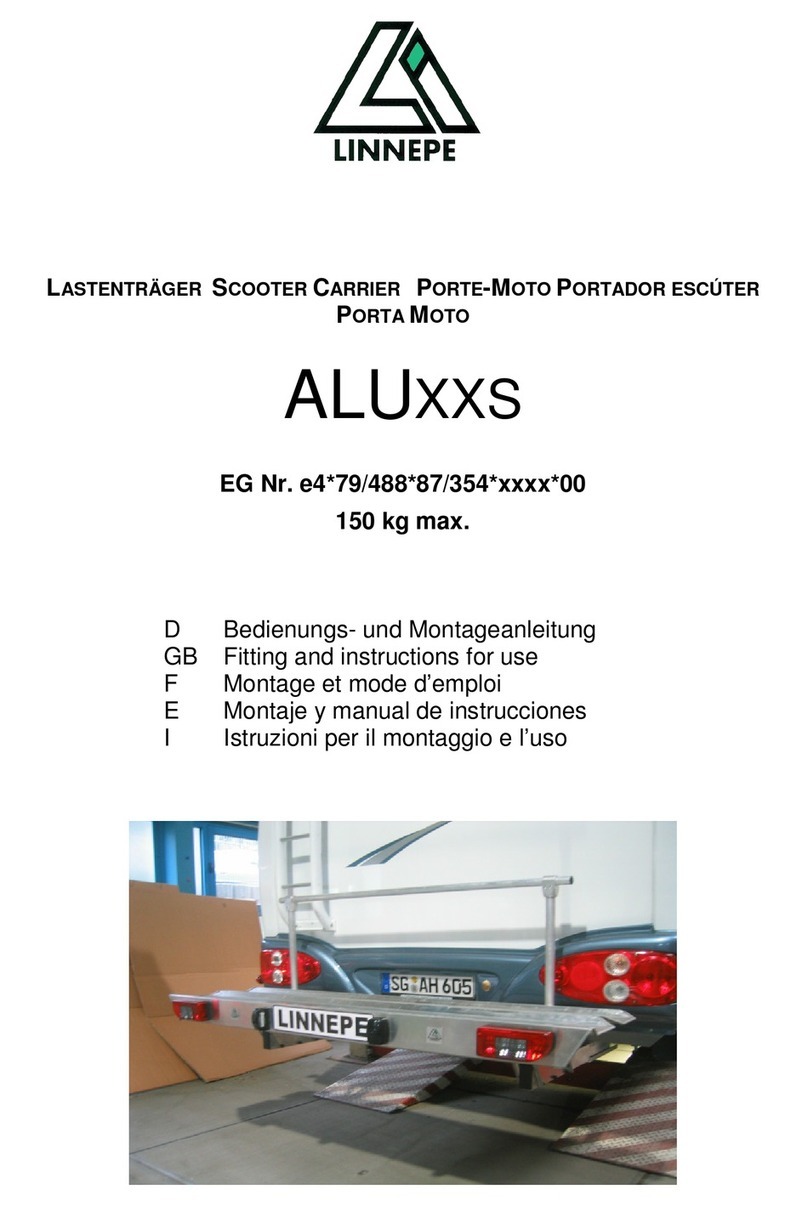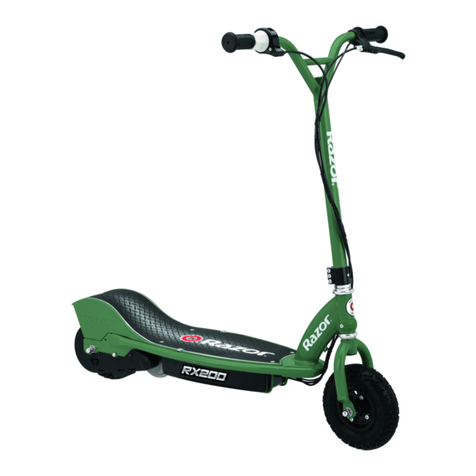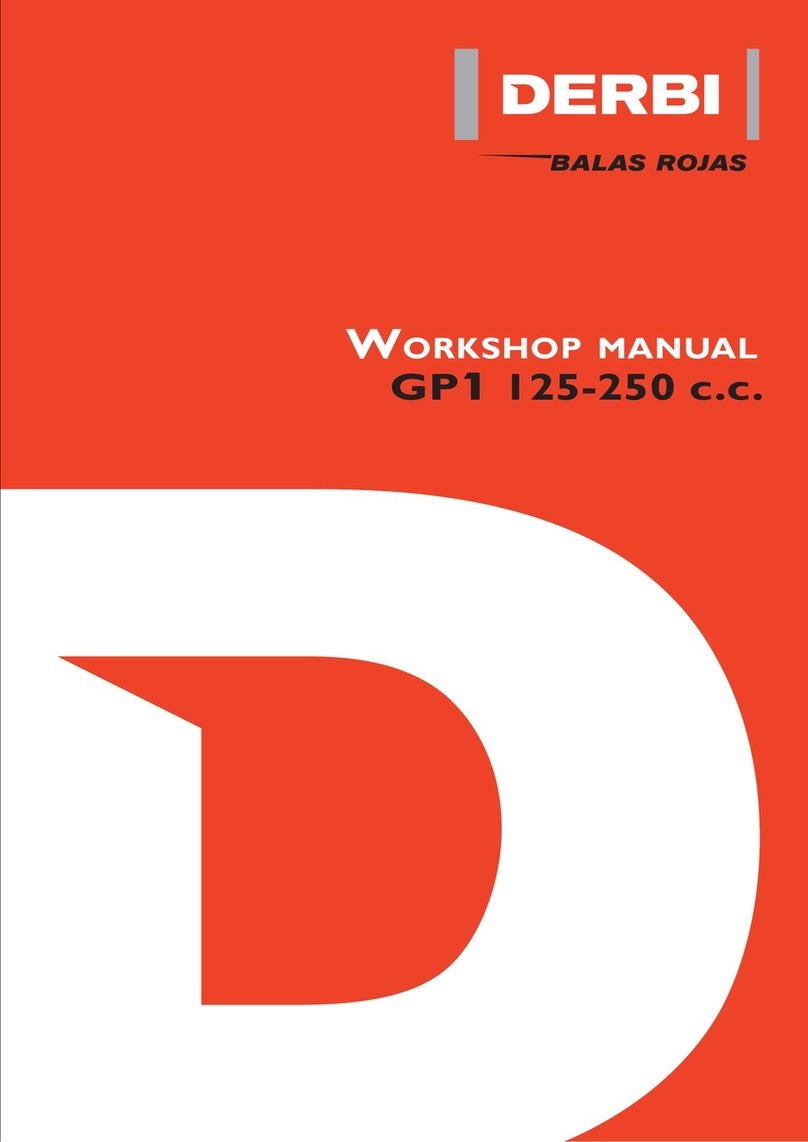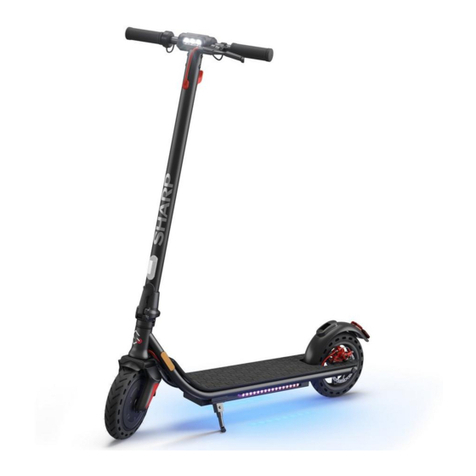Hikobike Pulse User manual

1
READ THIS GUIDE BEFORE RIDING YOUR EBIKE
USER GUIDE

2
CONTENTS
GENERAL PRECAUTIONS BEFORE RIDING
3
SPECIFICATIONS
3
BATTERY
4
BATTERY CHARGING
4
BATTERY STORAGE
5
INSTALLING AND REMOVING THE BATTERY
6
BATTERY WARNINGS
6
LED DISPLAY C600
7
CONTROL PANEL
8
QUICK START
9
NORMAL OPERATION
10
ON/OFF
10
POWER ASSISTS PAS SELECTION
10
HEAD LIGHT / REAR LIGHT AND BACKLIGHT DISPLAY INDICATOR
10
CURRENT DISPLAY
11
SET OPERATION (RIDING MODE,TRIP RESET,MAX SPEED, KM/H OR MPH)
12
BATTERY CAPACITY INDICATOR
13
BATTERY VOLTAGE
13
ERROR CODES
14
MAINTENANCE AND STORAGE
14
TORQUE SETTINGS
15
WARRANTY
16
CONTACT
16

3
ASSEMBLY
The assembly of your HIKOBIKE must be performed and safety checked by a HIKOBIKE dealer or
bicycle mechanic. Assembly of the stem, handle bars, and tuning of the gears and brakes requires
expert bicycle mechanic knowledge.
GENERAL PRECAUTIONS BEFORE RIDING
Always wear a safety bicycle helmet when riding a HIKOBIKE electric bike
Observe the local rules for bicycles and e-bikes
Check Tyre Pressure (35-60psi), brakes, fasteners, and locking systems before commencing on a ride
HIKO Bikes are designed for comfort for use on smooth gravel, dirt or paved surfaces. They are ideal
for maintained walking and biking tracks, but not for downhill or single track mountain bike type use.
HIKO bikes are not designed for jumps or extreme riding conditions.
SPECIFICATIONS
Model
PULSE
Weight without battery
21kgs
Maximum assist speed
35Km/hr
Maximum load carrying
130Kg
Motor
300Watt rear motor
Display
C600
Front Fork
Suntour NEX
Brakes
Tektro 180mm Disc
Derailler
Shimano Acera 8 Speed
Tires
Maxxis Pace 26 x 2.10
Battery
Weight
Samsung 13Ah with BMS
3Kgs

4
BATTERY
HIKO bikes come standard with a 13Ah Samsung Li-Ion Battery with a built in Battery Management
system (BMS). The BMS is important component as it allows the charger to charge the Samsung Cells
evenly which will maximise the life expectancy and storage power of the battery.
HIKO bikes can be upgraded with either a 15.4Ah Samsung BMS equipped, or 17Ah Panasonic BMS
equipped batteries. Your standard charger for the 13Ah battery can charge the two larger batteries.
Contact your dealer to purchase a larger battery.
BATTERY CHARGING
IMPORTANT: Use a Surge Protector with your battery charger to protect against spikes in household
voltage.
Charging time: 3 -6 hours for 100% Charge
Your Battery has and battery level indicator with 4 LED light showing the charge state. Press the
Button on top of the Battery to check battery level.
Only charge the battery in temperatures between 10 –30 deg C, in a dry and safe place. Do not
cover the battery during charging. If the battery is extremely cold, warm the battery in a warm
ambient room for a few hours before charging it.
To charge your battery follow these steps:
1. Plug the Chargers 3 pin plug into the Wall Socket / Surge Protector (which is OFF)
2. Plug the battery into the Charger.
3. Then Turn ON the Wall Socket/ Surge Protector to turn ON the Charger.
4. The Charger will show LED lights: RED –Battery is being Charged. Green the battery is
charged.
5. Once charged, turn OFF or unplug the Charger from the Wall Socket. The battery can remain
plugged into the Charger if the Charger is turned OFF or unplugged from the Wall Socket.
Do not leave the Charger ON connected to the battery for more than 24hrs. Always turn off the
Charger at the Wall Socket when the battery has completed charging.
Duration of 13Ah battery while riding can range from 40km to 80km depending on assist level
selected, rider input, and road conditions.
Never leave your battery fully discharged after a large ride. Charge the battery as soon as possible
with the next 12hrs

5
BATTERY STORAGE
Store your battery at dry temperatures between 15-25 deg C. Your battery likes the same
temperature you do.
When storing the battery for periods longer than 2 months, Fully charge the battery and remove the
charger from the wall socket. The Battery has a 4 bar Charge indicator on the battery pack. Push the
Button to see how many bars light up. Try to keep the battery with at least 2 bars showing.
The Li-Ion Battery will slowly lose its charge over long storage intervals.
It is important to check and charge the battery at least every 3 months, and keep the battery
charged between 20% and 100% level.
Allowing the battery to fully discharge during long storage can harm your battery.
Never leave your battery fully discharged as it may cause permanent damage to the battery

6
INSTALLING AND REMOVING THE BATTERY
To remove the battery from the frame, unlock the battery using the key, at the same time using the
battery lift out handle, pull the battery up and out.
To install the battery, insert the battery into the bottom of the battery frame, then push down on
the top the battery to locate the locking pin.
BATTERY WARNINGS
The Li-Ion battery is one of the major components on the HIKO ebike and great effort should be
taken to look after it.
•Always handle with great care. No not drop or allow it to be struck.
•Do not take the battery casing apart or tamper with the battery.
•Keep it away from Children.
•Keep it away from temperatures above 50 deg C
•Never allow a connection between the electrical contacts
•If you suspect the battery is damaged or not working suitable contact your dealer.
The Dealer can have the battery checked and diagnosed using the built-in battery management
system.

7
LED DISPLAY C600 AND CONTROL PANEL

8

9
QUICK START - RIDING THE BIKE
Before riding the bike, check the battery capacity.
Press the button on top of the battery.
The 4 LEDs on the battery below the button show the
battery charge level.
Turn on the C600 display by pressing down the ON button on the handlebar keypad.
Select the level of assist from 1- 5. Default is 0 (no assist).
You can hold down the SET button for 3 seconds to select/change POWER, STANDARD or ECO riding
mode. Hold down SET to return.
Start pedalling or use the hand throttle to start the motor
Select the appropriate gear
Pulling on either front or rear brake level will stop the motor immediately
For optimum battery life, try to avoid riding the ebike until the battery is completely flat. Turn off
the Power Assist as soon as you notice the battery has lost power and pedal the bike home, and
charge the battery as soon as possible.

10
NORMAL OPERATION
ON / OFF
Push ON/OFF to start the display. The display will provide power to the controller. Push ON/OFF
again to operate the backlight. With the display on, press ON/OFF for 3 seconds to turn the power
OFF.
The panel will go to sleep when the speed is o Km/h for 5 minutes
PAS LEVEL SELECTION
Click UP and DOWN to change the PAS level of assistance from 1 - 5. Default is level 0. (No Assist)
HEAD LIGHT / REAR LIGHT AND BACKLIGHT DISPLAY INDICATOR
With the display ON, click the ON/OFF button to turn on the head, tail lights and backlight of the
display. Click it again to turn OFF.

11
6KM/H PUSH MODE
This mode is handy when pushing your HIKO bike uphill.
Hold the DOWN button for 2 seconds to get into 6KM/H PAS mode, and keep the button pressed.
Release the button to stop 6KM/H mode.
CURRENT DISPLAY
This represents the amount of current used by the motor. Each segment about 2A.

12
SET MENU OPERATION
Hold the SET button for 2 seconds and enter the setting interface. Number 0 is displayed, and the
display will flash. Click the SET to cycle from 0 to 4. Press UP or DOWN to select the desired
parameter, and hold the SET for 1 second to exit.
SET 0 –RIDING MODE SELECTION
There are three modes:
POWER –fast acceleration and response, drawing maximum battery usage
NORMAL –normal acceleration
ECO –Economic acceleration, ideal for minimum battery usage
SET 1 –RESET TRIP 1 DISTANCE
Click the DOWN button to reset trip 1, TRIP1 icon will flash and the trip will be cleared.
SET 2 –MAX SPEED SETTING
Enter this
model to adjust MAX SPEED between 20 –40KM/H.
SET 3 –WHEEL DIAMETER SETTING
Do not adjust this setting as it affects speed and distance (Default 26”)
SET 4 –KM/H or MPH
Use this setting to select from either KM/H and KM or MPH and Miles

13
BATTERY CAPACITY INDICATOR
The battery indicator has 5 segments each representing 20% battery capacity. When the battery is
full the 5 segments all light up.
When the battery is severely low the last segment will flash. It is recommended to charge the
battery immediately. It is not recommended to discharge the battery completely while riding as this
can decrease the overall life of the battery.
BMS - BATTERY VOLTAGE
Displays the current voltage of the battery

14
ERROR CODES
Error
code
Definition
Trouble Shooting
0
Normal
1
Current error or Controller damage
Check Controller
2
Throttle error
Check Throttle
3
Motor No Phase position
Check Motor
4
Hall sensor error
Check Motor
5
Brake Error
Check Brakes
6
Under Voltage
Check Battery
7
Motor Stalling
Check Battery / Motor
8
Communication error from controller
Check Controller Connections
9
Communication error from display
Check Display Connections
MAINTENANCE AND STORAGE
Dealer and Bicycle mechanic routine maintenance:
Your bicycle must be returned to your servicing dealer or bicycle mechanic after 200km of riding
to re-tension the spokes. Then every 1000km for a general service and inspection. Failure to do
this can void your warranty due to unnecessary wear and tear.
User maintenance:
1. Oil the chain frequently, but using special bicycle lubricant (dry or wet). Apply the lube oil on
the chain by turning the pedals and dripping the lube oil on the chain as it moves past, and
spin for a few turns and change into all gears. It is easiest to do this on the bike stand or bike
carrier, with the wheels suspended off the ground. After applying the lube oil it is important
to clean off excess lube oil with a cloth. This removes old dirt that the new lube has
dislodged.
2. Keep tyres pressures within the tire recommendations; see tyres for max PSI inflation.
Normally 35-60psi gives a hard tyre pressure for efficient peddling and battery consumption.
3. Check brake disc pads for even wear patterns. If the brakes become noisy when applied,
take to a service bike shop to check to see if they need replacement.
4. Store your e-bike in a dry place and away from corrosive environments.

15
5. Torque Settings
Check bolts are tightened according to the following recommendations before you set off for the
first time.
a. Seat pillar clamp nut/bolt 5N.M-8N.M
b. Brake cable anchor bolt 5N.M
c. Brake centre bolt 11N.M
d. Seat angle clamp bolt 24N.M
e. Crank axle nuts R: 46N.M
f. Gear shifter nuts 4N.M
g. Rear carrier nuts 8N.M
h. Mudguard bracket nuts 8N.M
i. Handle bar clamp nut 17-20N.M
k. Seat tube clamp nut 4-7N.M
l. Quick release front axle. Measured torque not typically used. Common industry practice is
resistance at lever half way through swing from open to fully closed.
For all other nuts, the torque depends on the nut diameter:
M4 2.5-4.0N.M
M5 4.0-6.0N.M
M6 6.0-7.5N.M
Do’s and Don’t’s
Do treat your e-Bike like any bicycle you would want to last well… keep it stored somewhere
secure and away from the elements.
Don’t treat your e-Bike as a dirt-bike! The motor and battery are weather proof, but not water-
tight. It is ok in rain, but not to ford streams, etc!
Never take your e-Bike on the beach as salt water and sand will drastically shorten the lifespan
of many of the e-bike’s components (motor, gears, wiring connections, etc).
Note: Your warranty is void if evidence of salt, sand, or water damage are present within the
components. Important: If you live very close to the sea you must keep your bike indoors when
not in use. This will save you $$$ as your components will last longer.
Important: Your bike will arrive with the battery partially charged. You need to give it a full
charge before ANY use. Top your battery up after each use (lithium batteries prefer shallow
discharge).
Note: The LCD battery display bars will dip under full load (on hills, etc). This is normal as running
voltage drops under high load. To get an accurate battery reading, wait about 10 sec after the
motor is not in use.
Do take extra care on the road as you will be travelling faster than you normally do on a bike and
your bike is now power-assisted, so will behave differently.

16
WARRANTY
All HIKO bike’s and accessories are covered by warranty for 12 months from date of purchase.
Additionally the Battery and motor are covered by warranty for 2 years from date of purchase.
Frames are covered by warranty for 5 years from date of purchase.
Warranty work should only be carried out by authorised HIKO bike agents, and does not cover the
any transport costs.
The warranty does not cover normal wear on parts, or parts that have been damaged through
improper used or lack of maintenance.
CONTACT
www.hikobike.nz
Email: info@hikobike.co.nz
Table of contents
Other Hikobike Scooter manuals
